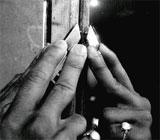Cutting edge
 two Indian scientists, Rustum Roy of Pennsylvania State University and Pravin Mistry of qqc Process, Dearborn, Michigan, both in the us, are spearheading a cheaper and more flexible process to boost the worldwide demand for synthetic diamonds. A process that creates pure diamonds and binds it to a surface with the ease of paint on a brush looks set to change the manufacture of objects from engines and transmission parts to dyes, sporting goods and cutting tools.
two Indian scientists, Rustum Roy of Pennsylvania State University and Pravin Mistry of qqc Process, Dearborn, Michigan, both in the us, are spearheading a cheaper and more flexible process to boost the worldwide demand for synthetic diamonds. A process that creates pure diamonds and binds it to a surface with the ease of paint on a brush looks set to change the manufacture of objects from engines and transmission parts to dyes, sporting goods and cutting tools.
Indian scientists state that most people think of diamonds as naturally occurring stones that must be mined but the human-made diamond has been used in manufacturing, mainly as inserts on metal-cutting tools, since it was invented in the '50s.Annual world sales of synthetic diamond amount to us $900 million, although the value of the cutting tools and grinders which use it is us $3.1 billion.
The new rapid-coating technology called qqc could expand the worldwide market for synthetic diamonds significantly. The qqc approach creates the diamond in an ordinary atmosphere, not the high-temperature vacuum used in standard diamond manufacture. Four laser beams are directed through a cloud of carbon dioxide at a tungsten carbide surface. The lasers break the carbon dioxide into oxygen and carbon. Diamond is formed from the bonding of this carbon with carbon atoms, which the laser energy has mobilised from the rotating tungsten carbide surface.
The object to be coated can be moved around by a robotic arm under the laser, precisely controlling deposition of the diamond. Adjustment of the lasers can control crystal size and structure. Most synthetic diamonds are made by chemical vapour deposition (cvd). But, in spite of years of effort, the cvd process can still coat only a few coin-sized shapes and this requires a vacuum chamber which must be heated to 800
Related Content
- Approach paper on draft National Pharmaceuticals Policy 2023
- Nature's frontiers: achieving sustainability, efficiency, and prosperity with natural capital
- National green hydrogen mission
- Opportunities and pathways to decarbonize China’s transportation sector during the fourteenth Five-Year Plan period and beyond
- Addressing the climate crisis: local action in theory and practice
- Toward a holistic approach to sustainable development: a guide to integrated land-use initiatives
